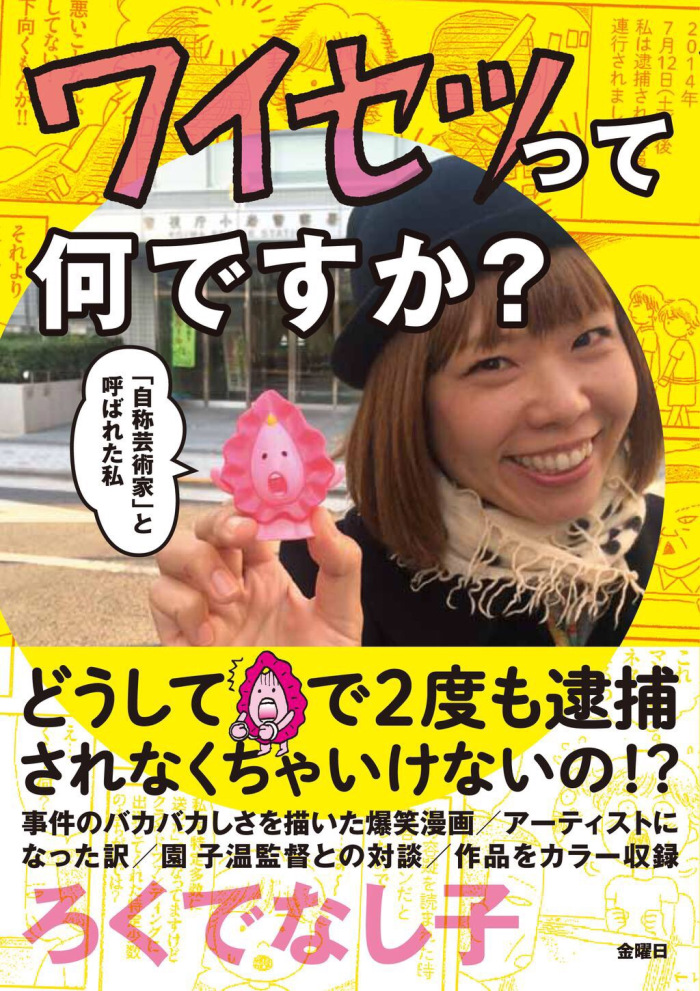The Japanese authorities apparently.

Megumi Igarashi, also known under her pseudonym Rokudenashiko (“good for nothing girl”), made headlines around the world when she was arrested twice in 2014 and 2016. What crime had she committed? Kayaking in a giant, 3D-printed version of her vulva and later, in 2016, exhibiting it in a sex shop.
Rokudenashiko describes her work as manko-art, manko means something along the lines of pussy, thus she makes pussy-art. On her website she explains that she used to be very insecure about how normal or abnormal her own vulva was, as she had never been exposed to realistic depictions. She didn’t know what a “normal” vulva looked like. So, she decided to do a plaster-cast of her own to get a better idea of what it looked like “down there”. However, the mould seemed too plain and boring to her, so she started decorating it. Since then, she has made numerous casts of her vulva and transformed them into dioramas (miniature models). She turned them into moon landscapes, beaches and golf courses. Other creations include vulva-moulded phone cases and miniature figurines. She also created a manga character, Manko Chan, which is a cute little pussy. The character featured in several mangas.

Golf Course Diorama. Courtesy of the Artist 
Fukushima Nuclear Disaster Diorama. Courtesy of the artist.
Then, in 2014 Rokudenashiko decided to do a life-sized manko-shaped kayak. To this end she scanned her vulva and 3D printed it. She crowd-funded her project and anyone who donated over ¥3,000 was sent the data of Rokudenashiko’s vulva to build their own vehicle if they wished to do so. She collected over a million yen.
The Japanese authorities arrested her soon after she had been paddling with her manko kayak on a lake. They charged her for obscenity.

Subsequently, Rokudenashiko spent ten days in prison in 2014. Eventually, the court ruled that the kayak was not obscene because, due to its bright yellow colour and decorations it was not immediately recognisable as a vagina and thus no disruption to public order. However, she was condemned to pay a fine concerning the scanning data. Sharing the data of her genitalia was considered scandalous enough, as people might reprint it with arousing ends in mind. This claim seems bold as nothing in Rokudenashiko’s art is erotic, she makes fun and pop art, but her vulva is never presented as a sexual organ. She even said in various interviews that she wanted her vulva to be considered just as any other body part “like an arm or a leg”.
One cannot stop but wonder how the authorities cannot see their own double standard. Why is it scandalous to use one’s own vulva to transform it into different pieces of art, but it is not scandalous to celebrate giant penises?

Every year people from all over the country flock together in the city of Kawasaki to celebrate prosperity around a penis-shrine. During the weekend people of all ages enjoy penis-shaped lollipops and ice cream. This event seems perfectly acceptable to the authorities but not a vulva-shaped kayak. Even the argument of dismissal reflects the sexism: since the kayak was not immediately recognisable it was deemed adequate. In the meantime, the lollipops licked by 7-year olds are not abstract phallic symbols vaguely evoking a penis. They are penis shaped.
So what makes penises more acceptable than vaginas?

On a more serious note, the possession of child pornography was made illegal in Japan only in 2014 – that is the same year as Rokudenashiko first trial. Manga porn is a thriving sub-genre that is usually not subjected to censorship even when it features child abuse. Again, it seems odd to argue that sharing one’s own data to people who donated toward her campaign is more arousing, and thus obscener, than mangas featuring explicit abuses of over-sexualised bodies.
Today, Rokudenashiko continues to create art inspired by vulvas. She has also turned her experiences in a book which was published in English: What is obscenity? It features manko-chan, the cute little vagina. She is also featured in the film #FemalePleasure which is worth watching.
While Rokudenashiko is of course seeking to break the taboos surrounding vaginas in Japanese society, her primary interest is creating art. She said that her work was not necessarily about empowerment or education but should be considered first and foremost art. Of course, empowerment, education and art are not necessarily mutually exclusive. They can be viewed separately but one could also argue that Rokudenashiko actually successfully merges the three.
The website Artists at Risk connection reported about Rokudenashiko’s case. It also features other artists subjected to censorship and how to help them.